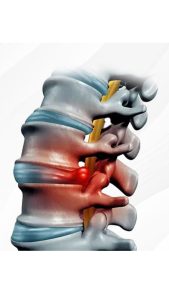
Lumbar Disc Bulges: What You Need to Know
Back pain doesn’t have to control your life. At Livfit Physio Mornington, we see people every day with lumbar disc bulges—and help them recover with the right advice, exercise, and hands-on care. Here’s what you need to know.
Anatomy of a Lumbar Disc Bulge
Your spine is made up of 24 bones (vertebrae) stacked on top of each other. Between these bones are discs—gel-filled cushions that absorb shock and allow movement. Each disc has a tough outer layer (annulus fibrosus) and a soft inner core (nucleus pulposus).

A disc bulge occurs when the inner gel pushes outward, stretching the outer layer. This can press on nearby nerves and cause symptoms like:
- Localised low back pain
- Pain shooting down the leg (sciatica)
Causes of Lumbar Disc Bulges
Disc bulges are often caused by a combination of poor posture, repetitive bending or lifting, and general wear and tear. Some key contributors include:
- Sitting too long (especially in poor posture)
- Lifting with poor technique
- Sudden twisting movements when bent over
What to Do in the First 3 Days
In the early phase of a disc injury, the goal is to reduce inflammation and avoid aggravating positions.
✅ Do this:
- Keep moving within pain limits—gentle walking is great.
- Use ice, but avoid anti-inflammatory medication if you can sleep at night and get through these tough early days. Research shows you recover more quickly if you let inflammation, which is part of the natural healing process, do it’s thing.
- Lie flat on your back with legs supported (e.g. on a chair) if pain is severe.
🚫 Avoid this:
- Prolonged sitting or slouching
- Bending forward repeatedly (e.g. to put on shoes, unload dishwasher). So make sure you ask for help!
Important: Bed rest is OK in the first 3 days. But make sure you spend at least one third your day on your feet, pottering around.
Day 3 to Day 14: Early Recovery
By now, inflammation should be settling and you can start introducing gentle rehab movements. If you’re struggling with pain and getting back to normal movement, anti-inflammatories are good to take in this period.
✅ Start gentle exercises that target:
- Unload the bulging disc in your back
- Restore movement
- Free up your Sciatic Nerve
- Begin Glute and Core Muscle activation exercises
This is the stage where physiotherapy is most helpful. We’ll assess the cause, give you tailored exercises, and help you avoid a repeat episode.
What NOT to Do
- Don’t ignore leg symptoms like numbness or weakness—tell your Physio if you get these
- Don’t rely on painkillers alone without addressing the cause.
- Don’t rush back to heavy lifting, gym work or running.
- Don’t Google “disc bulge” and assume surgery is inevitable—it’s not!
Long-Term Management: The Key to Staying Pain-Free
Once your pain settles, the real work begins—building strength, mobility, and better habits. At Livfit Physio, we use a combination of:
- Core and Postural muscle exercises
- Functional Strength training
- Education on posture and movement
- Lifestyle tips for desk setup, sleep, and daily activity
Our goal is to help you fix the problem and give you the tools to keep it fixed.